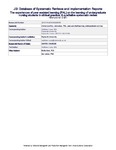Experiences of undergraduate nursing students in peer assisted learning in clinical practice: a qualitative systematic review
| dc.contributor.author | Carey, Matthew | |
| dc.contributor.author | Kent, B | |
| dc.contributor.author | Latour, Jos M | |
| dc.date.accessioned | 2018-01-16T13:26:38Z | |
| dc.date.available | 2018-01-16T13:26:38Z | |
| dc.date.issued | 2018-05 | |
| dc.identifier.issn | 2202-4433 | |
| dc.identifier.issn | 2202-4433 | |
| dc.identifier.uri | http://hdl.handle.net/10026.1/10590 | |
| dc.description.abstract |
<jats:title>ABSTRACT</jats:title> <jats:sec> <jats:title>Objectives:</jats:title> <jats:p>The objective of this qualitative systematic review was to identify and synthesize the best available evidence on experiences of peer assisted learning (PAL) among student nurses in clinical practice so as to understand the value of PAL for this population.</jats:p> </jats:sec> <jats:sec> <jats:title>Introduction:</jats:title> <jats:p>Peer-assisted learning considers the benefits of peers working in collaboration and supporting each other in professional roles. This approach to facilitate learning is effective within universities, but there is limited exploration within the clinical practice environment. Within the UK, 50% of student nurses’ learning is undertaken within clinical practice, providing a large portion of student allocation within these areas, but is unexplored in relation to PAL. Therefore, existing evidence examining PAL in clinical practice needs further exploration for a better understanding of its value to student nurses’ learning.</jats:p> </jats:sec> <jats:sec> <jats:title>Inclusion criteria:</jats:title> <jats:p>The systematic review considered studies that included male and female nursing students aged 18–50 years that explored undergraduate nursing students’ experiences of PAL within the clinical practice environment. Studies that utilized designs such as phenomenology, grounded theory, ethnography, action research and feminist research were considered. Other text such as opinion papers and reports were to be considered if no qualitative studies could be located. The review excluded quantitative studies, as well as those addressing PAL outside the nursing profession and students within the nursing profession but not including undergraduate student nurses. This review considered studies that included aspects related to experiences of PAL in the clinical practice setting, as seen by undergraduate nursing students and the researcher.</jats:p> </jats:sec> <jats:sec> <jats:title>Methods:</jats:title> <jats:p>A three-step search strategy was undertaken to find both published and unpublished studies in English from 2003 to 2017 in various databases, and included searching of reference lists within articles selected for appraisal. Each of the included studies were assessed for methodological quality independently by two reviewers, using the Joanna Briggs Institute Critical Appraisal Form for Interpretive and Critical Research. Qualitative data was extracted using the standardized JBI qualitative data extraction tool. Qualitative research findings were synthesized using JBI methodology.</jats:p> </jats:sec> <jats:sec> <jats:title>Results:</jats:title> <jats:p>From the eight included studies, 37 findings were extracted. These findings were further aggregated into seven categories, and then into three synthesized findings. These three synthesized findings are: 1) Challenges of clinical practice are mitigated by peer support; 2) Peers are role models for enhancing clinical knowledge; and 3) Support and feedback develop competence and confidence, and reduce stress and anxiety.</jats:p> </jats:sec> <jats:sec> <jats:title>Conclusions:</jats:title> <jats:p>Peer-assisted learning exists in clinical practice in both formal and informal circumstances. Friendship and community are often expressed as occurring when peers work together. Support and feedback help students develop in their clinical role and enhance clinical knowledge. Outcomes include enhancing the competency and confidence of peers, and reducing stress and anxiety. Challenges of clinical practice are mitigated through PAL.</jats:p> </jats:sec> | |
| dc.format.extent | 1190-1219 | |
| dc.format.medium | ||
| dc.language | en | |
| dc.language.iso | en | |
| dc.publisher | Lippincott, Williams & Wilkins | |
| dc.subject | Clinical Clerkship | |
| dc.subject | Clinical Competence | |
| dc.subject | Humans | |
| dc.subject | Learning | |
| dc.subject | Peer Group | |
| dc.subject | Qualitative Research | |
| dc.subject | Students, Nursing | |
| dc.title | Experiences of undergraduate nursing students in peer assisted learning in clinical practice: a qualitative systematic review | |
| dc.type | journal-article | |
| dc.type | Journal Article | |
| dc.type | Systematic Review | |
| plymouth.author-url | https://www.ncbi.nlm.nih.gov/pubmed/29762313 | |
| plymouth.issue | 5 | |
| plymouth.volume | 16 | |
| plymouth.publication-status | Published | |
| plymouth.journal | JBI Database of Systematic Reviews and Implementation Reports | |
| dc.identifier.doi | 10.11124/JBISRIR-2016-003295 | |
| plymouth.organisational-group | /Plymouth | |
| plymouth.organisational-group | /Plymouth/Faculty of Health | |
| plymouth.organisational-group | /Plymouth/Faculty of Health/School of Nursing and Midwifery | |
| plymouth.organisational-group | /Plymouth/REF 2021 Researchers by UoA | |
| plymouth.organisational-group | /Plymouth/REF 2021 Researchers by UoA/UoA03 Allied Health Professions, Dentistry, Nursing and Pharmacy | |
| plymouth.organisational-group | /Plymouth/Research Groups | |
| plymouth.organisational-group | /Plymouth/Research Groups/Institute of Health and Community | |
| plymouth.organisational-group | /Plymouth/Research Groups/Plymouth Institute of Health and Care Research (PIHR) | |
| plymouth.organisational-group | /Plymouth/Users by role | |
| plymouth.organisational-group | /Plymouth/Users by role/Academics | |
| dc.publisher.place | Australia | |
| dcterms.dateAccepted | 2018-01-15 | |
| dc.rights.embargodate | 2019-5-1 | |
| dc.identifier.eissn | 2202-4433 | |
| dc.rights.embargoperiod | Not known | |
| rioxxterms.versionofrecord | 10.11124/JBISRIR-2016-003295 | |
| rioxxterms.licenseref.uri | http://www.rioxx.net/licenses/all-rights-reserved | |
| rioxxterms.licenseref.startdate | 2018-05 | |
| rioxxterms.type | Journal Article/Review |


